The Quran (English pronunciation: /kɒˈrɑːn/ kor-ahn; Arabic: القرآن al-qurʾān, IPA: [qurˈʔaːn],[variations]literally meaning "the recitation"), also transliterated Qur'an, Koran, Alcoran, Qur’ān, Coran,Kuran, and al-Qur’ān, is the central religious text of Islam, which Muslims consider the verbatim word of God[1] (Arabic: الله, Allah). It is regarded widely as the finest piece of literature in the Arabic language.[2][3][4][5][6]
 The Quran is composed of verses (Ayah) that make up 114 chapters (suras) of unequal length which are classified either as Meccan or Medinan depending upon their place and time of revelation.[7] Muslims believe the Quran to be verbally revealed through angel Jibrīl (Gabriel) from God to Muhammad gradually over a period of approximately 23 years beginning in 610 CE, when Muhammad was 40, and concluding in 632 CE, the year of his death.[1][8][9]
The Quran is composed of verses (Ayah) that make up 114 chapters (suras) of unequal length which are classified either as Meccan or Medinan depending upon their place and time of revelation.[7] Muslims believe the Quran to be verbally revealed through angel Jibrīl (Gabriel) from God to Muhammad gradually over a period of approximately 23 years beginning in 610 CE, when Muhammad was 40, and concluding in 632 CE, the year of his death.[1][8][9]
Shortly after Muhammad's death the Quran was compiled into a single book by order of the firstCaliph Abu Bakr and at the suggestion of his future successor Umar. Hafsa, Muhammad's widow and Umar's daughter, was entrusted with that Quranic text after the second Caliph Umar died.[10] When the third Caliph Uthman began noticing slight differences in Arabic dialect, he sought Hafsa's permission to use her text to be set as the standard dialect, the Quraish dialect now known as Fus'ha (Modern Standard Arabic). Before returning the text to Hafsa, Uthman made several thousand copies of Abu Bakr's redaction and, to standardize the text, invalidated all other versions of the Quran. This process of formalization is known as the "Uthmanic recension".[11] The present form of the Quran text is accepted by most scholars as the original version compiled by Abu Bakr.[11][12]
Muslims regard the Quran as the main miracle of Muhammad, the proof of his prophethood[13]and the culmination of a series of divine messages that started with the messages revealed toAdam, regarded in Islam as the first prophet,[14] and continued with the Suhuf Ibrahim (Scrolls of Abraham),[15] the Tawrat (Torah or Pentateuch) of Moses,[16][17] the Zabur (Tehillim or Book of Psalms) of David,[18][19] and the Injil (Gospel) of Jesus.[20][21][22] The Quran assumes familiarity with major narratives recounted in Jewish and Christian scriptures, summarizing some, dwelling at length on others and in some cases presenting alternative accounts and interpretations of events.[23][24][25] The Quran describes itself as a book of guidance, sometimes offering detailed accounts of specific historical events, and often emphasizing the moral significance of an event over its narrative sequence.[26][27]
Etymology and meaning
The word qurʾān appears about 70 times in the Quran itself, assuming various meanings. It is a verbal noun (maṣdar) of the Arabic verb qaraʾa (Arabic: قرأ), meaning “he read” or “he recited.” The Syriacequivalent is qeryānā, which refers to “scripture reading” or “lesson”. While most Western scholars consider the word to be derived from the Syriac, the majority of Muslim authorities hold the origin of the word is qaraʾa itself.[28] In any case, it had become an Arabic term by Muhammad's lifetime.[1] An important meaning of the word is the “act of reciting”, as reflected in an early Quranic passage: “It is for Us to collect it and to recite it (qurʾānahu)”.[29]
In other verses, the word refers to “an individual passage recited [by Muhammad]”. Its liturgical context is seen in a number of passages, for example: "So when al-qurʾān is recited, listen to it and keep silent".[30] The word may also assume the meaning of a codified scripture when mentioned with other scriptures such as the Torah and Gospel.[31]
The term also has closely related synonyms that are employed throughout the Quran. Each synonym possesses its own distinct meaning, but its use may converge with that of qurʾān in certain contexts. Such terms include kitāb (“book”); āyah (“sign”); and sūrah (“scripture”). The latter two terms also denote units of revelation. In the large majority of contexts, usually with a definite article (al-), the word is referred to as the “revelation” (wahy), that which has been “sent down” (tanzīl) at intervals.[32][33] Other related words are: dhikr, meaning "remembrance," used to refer to the Quran in the sense of a reminder and warning; and hikma, meaning “wisdom”, sometimes referring to the revelation or part of it.[28][34]
The Quran has many other names. Among those found in the text itself are al-furqān (“discernment” or “criterion”), al-hudah (“"the guide”),ḏikrallāh (“the remembrance of God”), al-ḥikmah (“the wisdom”), and kalāmallāh (“the word of God”). Another term is al-kitāb (“the book”), though it is also used in the Arabic language for other scriptures, such as the Torah and the Gospels. The term muṣḥaf ("written work") is often used to refer to particular Quranic manuscripts but is also used in the Quran to identify earlier revealed books.[1]
History
Main article: History of the Quran
Prophetic era
See also: Wahy
Islamic tradition relates that Muhammad received his first revelation in the Cave of Hira during one of his isolated retreats to the mountains. Thereafter, he received revelations over a period of twenty-three years. According to hadith and Muslim history, after Muhammad emigrated to Medina and formed an independent Muslim community, he ordered a considerable number of the sahabah to recite the Quran and to learn and teach the laws, which were revealed daily. Companions who engaged in the recitation of the Quran were called Qari. Since mostsahabah were unable to read or write, they were ordered to learn from the prisoners-of-war the simple writing of the time. Thus a group ofsahabah gradually became literate. As it was initially spoken, the Quran was recorded on tablets, bones and the wide, flat ends of date palmfronds. Most chapters were in use amongst early Muslims since they are mentioned in numerous sayings by both Sunni and Shia sources, relating Muhammad's use of the Quran as a call to Islam, the making of prayer and the manner of recitation. However, the Quran did not exist in book form at the time of Muhammad's death in 632.[35][36]
Sahih Bukhari narrates Muhammad describing the revelations as, "Sometimes it is (revealed) like the ringing of a bell" and Aisha reported, "I saw the Prophet being inspired Divinely on a very cold day and noticed the sweat dropping from his forehead (as the Inspiration was over)".[37]The Islamic studies scholar Welch states in the Encyclopaedia of Islam that he believes the graphic descriptions of Muhammad's condition at these moments may be regarded as genuine, because he was severely disturbed after these revelations. According to Welch, these seizures would have been seen by those around him as convincing evidence for the superhuman origin of Muhammad's inspirations. However, Muhammad's critics accused him of being a possessed man, a soothsayer or a magician since his experiences were similar to those claimed by such figures well known in ancient Arabia. Welch additionally states that it remains uncertain whether these experiences occurred before or after Muhammad's initial claim of prophethood.[38]
The Quran states that Muhammad was ummi,[39] interpreted as illiterate in Muslim tradition. According to Watt, the meaning of the Quranic term ummi is unscriptured rather than illiterate.
Compiling the Mus'haf
According to Shias, Sufis and scarce Sunni scholars, Ali compiled a complete version of the Quranmus'haf[1] immediately after Muhammad's death. The order of this mus'haf differed from that gathered later during Uthman's era. Despite this, Ali made no objection or resistance against standardized mus'haf, but kept his own book.[35][40]
After seventy reciters were killed in the Battle of Yamama, the caliph Abu Bakr decided to collect the different chapters and verses into one volume. Thus, a group of reciters, including Zayd ibn Thabit, collected the chapters and verses and produced several hand-written copies of the complete book.[35][41]
In about 650, as Islam expanded beyond the Arabian peninsula into Persia, the Levant and North Africa, the third caliph Uthman ibn Affan ordered the preparation of an official, standardized version, to preserve the sanctity of the text (and perhaps to keep the Rashidun Empire united, see Uthman Qur'an). Five reciters from amongst the companions produced a unique text from the first volume, which had been prepared on the orders of Abu Bakr and was kept with Hafsa bint Umar. The other copies already in the hands of Muslims in other areas were collected and sent to Medina where, on orders of the Caliph, they were destroyed by burning or boiling. This remains the authoritative text of the Quran to this day.[35][42][43]
The Quran in its present form is generally considered by academic scholars to record the words spoken by Muhammad because the search for variants in Western academia has not yielded any differences of great significance. Historically, controversy over the Quran's content has rarely become an issue, although debates continue on the subject.[44][45]
Significance in Islam
Muslims believe the Quran to be the book of divine guidance and direction for humanity and consider the text in its original Arabic to be the literal word of God,[46] revealed to Muhammadthrough the angel Gabriel over a period of twenty-three years[8][9] and view the Quran as God's final revelation to humanity.[8][47]
Wahy in Islamic and Quranic concept means the act of God addressing an individual, conveying a message for a greater number of recipients. The process by which the divine message comes to the heart of a messenger of God is tanzil (to send down) or nuzul (to come down). As the Quran says, "With the truth we (God) have sent it down and with the truth it has come down." It designates positive religion, the letter of the revelation dictated by the angel to the prophet. It means to cause this revelation to descend from the higher world. According to hadith, the verses were sent down in special circumstances known as asbab al-nuzul. However, in this view God himself is never the subject of coming down.[48]
The Quran frequently asserts in its text that it is divinely ordained, an assertion that Muslims believe. The Quran – often referring to its own textual nature and reflecting constantly on its assertion of divine origin – is the most meta-textual, self-referential religious text. The Quran refers to a written pre-text that records God's speech even before it was sent down.[49][50]
The issue of whether the Quran is eternal or created was one of the crucial controversies among early Muslim theologians. Mu'tazilis believe it is created while the most widespread varieties of Muslim theologians consider the Quran to be eternal and uncreated. Sufi philosophers view the question as artificial or wrongly framed.[51]
Muslims maintain the present wording of the Quranic text corresponds exactly to that revealed to Muhammad himself: as the words of God, said to be delivered to Muhammad through the angel Gabriel. Muslims consider the Quran to be a guide, a sign of the prophethood of Muhammad and the truth of the religion. They argue it is not possible for a human to produce a book like the Quran, as the Quran itself maintains.
Therefore an Islamic philosopher introduces a prophetology to explain how the divine word passes into human expression. This leads to a kind of esoteric hermeneutics that seeks to comprehend the position of the prophet by mediating on the modality of his relationship not with his own time, but with the eternal source his message emanates from. This view contrasts with historical critique of western scholars who attempt to understand the prophet through his circumstances, education and type of genius.[52]
Uniqueness
See also: Quran and miracles
Muslims believe that the Quran is different from all other books in ways that are impossible for any other book to be, such that similar texts cannot be written by humans. These include both mundane and miraculous claims. The Quran itself challenges any who disagree with its divine origin to produce a text of a miraculous nature.[53]
Scholars of Islam believe that its poetic form is unique and of a fashion that cannot be written by humans. They also claim it contains accurate prophecy and that no other book does.[54][55][56][57][58]
Text
The text of the Quran consists of 114 chapters of varying lengths, each known as a sura. Chapters are classed as Meccan or Medinan, depending on when (before or after Hijra) the verses were revealed. Chapter titles are derived from a name or quality discussed in the text, or from the first letters or words of the sura. Muslims believe that Muhammad, on God's command, gave the chapters their names.[1] Generally, longer chapters appear earlier in the Quran, while the shorter ones appear later. The chapter arrangement is thus not connected to the sequence of revelation. Each sura except the ninth starts with the Basmala,[59] an Arabic phrase meaning (“In the name of God, Most Gracious, Most Merciful”). There are, however, still 114 occurrences of the basmala in the Quran, due to its presence in verse 27:30 as the opening of Solomon's letter to the Queen of Sheba.[60]
Each sura is formed from several ayat (verses), which originally means a sign or portent sent by God. The number of verses differ from chapter to chapter. An individual verse may be just a few letters or several lines. The verses are unlike the highly refined poetry of the pre-Islamic Arabs in their content and distinctive rhymes and rhythms, being more akin to the prophetic utterances marked by inspired discontinuities found in the sacred scriptures of Judaism and Christianity. The actual number of ayat has been a controversial issue among Muslim scholars since Islam's inception, some recognizing 6,000, some 6,204, some 6,219, and some 6,236, although the words in all cases are the same. The most popular edition of the Quran, which is based on the Kufa school tradition, contains 6,236 ayat.[1]
There is a crosscutting division into 30 parts of roughly equal division, ajza, each containing two units called ahzab, each of which is divided into four parts (rub 'al-ahzab). The Quran is also divided into seven approximately equal parts, manazil, for it to be recited in a week.[1]
The Quranic text seems to have no beginning, middle, or end, its nonlinear structure being akin to a web or net.[1] The textual arrangement is sometimes considered to have lack of continuity, absence of any chronological or thematic order, and presence of repetition.[61][62]
Fourteen different Arabic letters form 14 different sets of “Quranic Initials” (the "Muqatta'at", such as A.L.M. of 2:1) and prefix 29 suras in the Quran. The meaning and interpretation of these initials is considered unknown to most Muslims.
In 1974, Egyptian biochemist Rashad Khalifa claimed to have discovered a mathematical code based on the number 19,[63] which is mentioned in Sura 74:30[64] of the Quran. This code only manifests itself in a version of Quran that Khalifa published himself and which differs from the one accepted by most Muslims. It is the basis for the beliefs of United Submitters International, a religious group that Khalifa founded.
Content
Main articles: Justice in the Quran and Quran and science
See also: Legends and the Quran
The Quranic verses contain general exhortations regarding right and wrong and the nature of revelation.
Historical events are related to outline general moral lessons.
Verses pertaining to natural phenomena have been interpreted by Muslims as an indication of the authenticity of the Quranic message.
Literary structure
The Quran's message is conveyed with various literary structures and devices. In the original Arabic, the chapters and verses employphonetic and thematic structures that assist the audience's efforts to recall the message of the text. Muslims[who?] assert (according to the Quran itself) that the Quranic content and style is inimitable.[65]
Richard Gottheil and Siegmund Fränkel in the Jewish Encyclopedia write that the oldest portions of the Quran reflect significant excitement in their language, through short and abrupt sentences and sudden transitions. The Quran nonetheless carefully maintains the rhymed form, like the oracles. Some later portions also preserve this form but also in a style where the movement is calm and the style expository.[66][verification needed]
Michael Sells, citing the work of the critic Norman O. Brown, acknowledges Brown's observation that the seeming "disorganization" of Quranic literary expression – its "scattered or fragmented mode of composition," in Sells's phrase – is in fact a literary device capable of delivering "profound effects – as if the intensity of the prophetic message were shattering the vehicle of human language in which it was being communicated."[67][68] Sells also addresses the much-discussed "repetitiveness" of the Quran, seeing this, too, as a literary device.
Interpretation and meanings
Tafsir
Main article: Tafsir
The Quran has sparked a huge body of commentary and explication (tafsir), aimed at explaining the "meanings of the Quranic verses, clarifying their import and finding out their significance."[69]
Tafsir is one of the earliest academic activities of Muslims. According to the Quran, Muhammad was the first person who described the meanings of verses for early Muslims.[70] Other early exegetes included a few Companions of Muhammad, like Ali ibn Abi Talib, Abdullah ibn Abbas, Abdullah ibn Umar and Ubayy ibn Kab. Exegesis in those days was confined to the explanation of literary aspects of the verse, the background of its revelation and, occasionally, interpretation of one verse with the help of the other. If the verse was about a historical event, then sometimes a few traditions (hadith) of Muhammad were narrated to make its meaning clear.[71]
Because the Quran is spoken in classical Arabic, many of the later converts to Islam (mostly non-Arabs) did not always understand the Quranic Arabic, they did not catch allusions that were clear to early Muslims fluent in Arabic and they were concerned with reconciling apparent conflict of themes in the Quran. Commentators erudite in Arabic explained the allusions, and perhaps most importantly, explained which Quranic verses had been revealed early in Muhammad's prophetic career, as being appropriate to the very earliest Muslim community, and which had been revealed later, canceling out or "abrogating" (nasikh) the earlier text (mansukh).[72][73] Other scholars, however, maintain that no abrogation has taken place in the Qur'an.[74]
Ta'wil
Main article: Esoteric interpretation of the Quran
See also: Quranic hermeneutics and Exegesis
Ja'far Kashfi defines ta'wil as 'to lead back or to bring something back to its origin or archetype'. It is a science whose pivot is a spiritual direction and a divine inspiration, while the tafsir is the literal exegesis of the letter; its pivot is the canonical Islamic sciences.[75] Muhammad Husayn Tabatabaei says that according to the popular explanation among the later exegetes, ta'wil indicates the particular meaning a verse is directed towards. The meaning of revelation (tanzil), as opposed to ta'wil, is clear in its accordance to the obvious meaning of the words as they were revealed. But this explanation has become so widespread that, at present, it has become the primary meaning of ta'wil, which originally meant "to return" or "the returning place". In Tabatabaei's view, what has been rightly called ta'wil, or hermeneutic interpretation of the Quran, is not concerned simply with the denotation of words. Rather, it is concerned with certain truths and realities that transcend the comprehension of the common run of men; yet it is from these truths and realities that the principles of doctrine and the practical injunctions of the Quran issue forth. Interpretation is not the meaning of the verse; rather it transpires through that meaning – a special sort of transpiration. There is a spiritual reality, which is the main objective of ordaining a law, or the basic aim in describing a divine attribute—and there is an actual significance a Quranic story refers to.[76][77]
According to Shia beliefs, those who are firmly rooted in knowledge like the Prophet and the imams know the secrets of the Quran. According to Tabatabaei, the statement "none knows its interpretation except Allah" remains valid, without any opposing or qualifying clause. Therefore, so far as this verse is concerned, the knowledge of the Quran's interpretation is reserved for God. But Tabatabaei uses other verses and concludes that those who are purified by God know the interpretation of the Quran to a certain extent.[77] As Corbin narrates from Shia sources, Ali himself gives this testimony:
Not a single verse of the Quran descended upon (was revealed to) the Messenger of God, which he did not proceed to dictate to me and make me recite. I would write it with my own hand, and he would instruct me as to its tafsir (the literal explanation) and the ta'wil (the spiritual exegesis), the nasikh (the verse that abrogates) and the mansukh (the abrogated verse), the muhkam(without ambiguity) and the mutashabih (ambiguous), the particular and the general...[78]
According to Tabatabaei, there are acceptable and unacceptable esoteric interpretations. Acceptable ta'wil refers to the meaning of a verse beyond its literal meaning; rather the implicit meaning, which ultimately is known only to God and can't be comprehended directly through human thought alone. The verses in question here refer to the human qualities of coming, going, sitting, satisfaction, anger, and sorrow, which are apparently attributed to God. Unacceptable ta'wil is where one "transfers" the apparent meaning of a verse to a different meaning by means of a proof; this method is not without obvious inconsistencies. Although this unacceptable ta'wil has gained considerable acceptance, it is incorrect and cannot be applied to the Quranic verses. The correct interpretation is that reality a verse refers to. It is found in all verses, the decisive and the ambiguous alike; it is not a sort of a meaning of the word; it is a fact that is too sublime for words. God has dressed them with words to bring them a bit nearer to our minds; in this respect they are like proverbs that are used to create a picture in the mind, and thus help the hearer to clearly grasp the intended idea.[77][79]
Therefore Sufi spiritual interpretations are usually accepted by Islamic scholars as authentic, as long as certain conditions are met.[80] In Sufi history, these interpretations were sometimes considered religious innovations (bid'ah), as Salafis believe today. However, ta'wil is extremely controversial even amongst Shia. For example, when Ayatollah Ruhallah Khomeini, the leader of Islamic revolution, gave some lectures aboutSura al-Fatiha in December 1979 and January 1980, protests forced him to suspend them before he could continue beyond the first two verses of the surah.[81]
Levels of meaning
Unlike the Salafis and Zahiri, Shias and Sufis as well as some Muslim philosophers believe the meaning of the Quran is not restricted to the literal aspect.[82] For them, it is an essential idea that the Quran also has inward aspects. Henry Corbin narrates a hadith that goes back toMuhammad:
"The Qur'an possesses an external appearance and a hidden depth, an exoteric meaning and an esoteric meaning. This esoteric meaning in turn conceals an esoteric meaning (this depth possesses a depth, after the image of the celestial Spheres, which are enclosed within each other). So it goes on for seven esoteric meanings (seven depths of hidden depth)."[82]
According to this view, it has also become evident that the inner meaning of the Quran does not eradicate or invalidate its outward meaning. Rather, it is like the soul, which gives life to the body.[83] Corbin considers the Quran to play a part in Islamic philosophy, becausegnosiology itself goes hand in hand with prophetology.[84]
Commentaries dealing with the zahir (outward aspects) of the text are called tafsir, and hermeneutic and esoteric commentaries dealing with the batin are called ta'wil (“interpretation” or “explanation”), which involves taking the text back to its beginning. Commentators with an esoteric slant believe that the ultimate meaning of the Quran is known only to God.[1] In contrast, Quranic literalism, followed by Salafis andZahiris, is the belief that the Quran should only be taken at its apparent meaning.
Translations
Main article: Quran translations
See also: List of translations of the Quran
Translation of the Quran has always been a problematic and difficult issue. Many argue that the Quranic text cannot be reproduced in another language or form.[85] Furthermore, an Arabic word may have a range of meanings depending on the context, making an accurate translation even more difficult.[86]
The first complete translation of the Quran was completed in 884 CE in Alwar (Sindh, India now Pakistan) by the orders of Abdullah bin Umar bin Abdul Aziz on the request of the Hindu Raja Mehruk.[87]
Nevertheless, the Quran has been translated into most African, Asian and European languages.[86] The first translator of the Quran was Salman the Persian, who translated sura Al-Fatiha into Persian during the 7th century.[88] The first complete translation of Quran was into Persian during the reign of Samanids in the 9th century. Islamic tradition holds that translations were made for Emperor Negus of Abyssinia and Byzantine Emperor Heraclius, as both received letters by Muhammad containing verses from the Quran.[86]In early centuries, the permissibility of translations was not an issue, but whether one could use translations in prayer.
In 1936, translations in 102 languages were known.[86] In 2010, the Hürriyet Daily News and Economic Review reported that the Quran was presented in 112 languages at the 18th International Quran Exhibition in Tehran.[89]
Robert of Ketton's 1143 translation of the Quran for Peter the Venerable, Lex Mahumet pseudoprophete, was the first into a Western language (Latin).[90] Alexander Ross offered the first English version in 1649, from the French translation of L'Alcoran de Mahomet (1647) by Andre du Ryer. In 1734, George Sale produced the first scholarly translation of the Quran into English; another was produced by Richard Bell in 1937, and yet another by Arthur John Arberry in 1955. All these translators were non-Muslims. There have been numerous translations by Muslims.
The English translators have sometimes favored archaic English words and constructions over their more modern or conventional equivalents; for example, two widely read translators, A. Yusuf Ali and M. Marmaduke Pickthall, use the plural and singular "ye" and "thou" instead of the more common "you".[91]
Literary usage
In addition to and largely independent of the division into suras, there are various ways of dividing the Quran into parts of approximately equal length for convenience in reading, recitation and memorization. The thirtyajza can be used to read through the entire Quran in a week or a month. Some of these parts are known by names and these names are the first few words by which the juz' starts. A juz' is sometimes further divided into two ahzab, and each hizb subdivided into four rub 'al-ahzab. A different structure is provided by the ruku'at, semantical units resembling paragraphs and comprising roughly ten ayat each. Some also divide the Quran into seven manazil to facilitate complete recitation in a week.
Recitation
| “ | ...and recite the Quran in slow, measured rhythmic tones. | ” |
See also: Tajwid
One meaning of Quran is "recitation". Tajwid, an Arabic word for elocution, is a set of rules that governs how the Quran should be recited and is assessed in terms of how accessible the recitation is to those intent on concentrating on the words.[92]
To perform salat (prayer), a mandatory obligation in Islam, a Muslim is required to learn at least some sura of the Quran (typically starting with the first one, al-Fatiha, known as the "seven oft-repeated verses," and then moving on to the shorter ones at the end). Until one has learned al-Fatiha, a Muslim can only say phrases like "praise be to God" during the salat.
A person whose recital repertoire encompasses the whole Quran is called a qari', whereas a memoriser of the Quran is called a hafiz (fem. Hafaz) (which translate as "reciter" or "protector," respectively). Muhammad is regarded as the first qari' since he was the first to recite it. Recitation (tilawa تلاوة) of the Quran is a fine art in the Muslim world.
Schools of recitation
Main article: Qira'at
There are several schools of Quranic recitation, all of which teach possible pronunciations of the Uthmanic rasm: Seven reliable, three permissible and (at least) four uncanonical – in 8 sub-traditions each – making for 80 recitation variants altogether.[93] A canonical recitation must satisfy three conditions:
- It must match the rasm, letter for letter.
- It must conform with the syntactic rules of the Arabic language.
- It must have a continuous isnad to Muhammad through tawatur, meaning that it has to be related by a large group of people to another down the isnad chain.
These recitations differ in the vocalization (tashkil) of a few words, which in turn gives a complementary meaning to the word in question according to the rules of Arabic grammar. For example, the vocalization of a verb can change its active and passive voice. It can also change its stem formation, implying intensity for example. Vowels may be elongated or shortened, and glottal stops (hamzas) may be added or dropped, according to the respective rules of the particular recitation. For example, the name of archangel Gabriel is pronounced differently in different recitations: Jibrīl, Jabrīl, Jibra'īl, and Jibra'il.
The more widely used narrations are those of Hafs (حفص عن عاصم), Warsh (ورش عن نافع), Qaloon (قالون عن نافع) and Al-Duri according to Abu `Amr(الدوري عن أبي عمرو). Muslims firmly believe that all canonical recitations were recited by Muhammad himself, citing the respective isnad chain of narration, and accept them as valid for worshipping and as a reference for rules of Sharia. The uncanonical recitations are called "explanatory" for their role in giving a different perspective for a given verse or ayah. Today several dozen persons hold the title "Memorizer of the Ten Recitations."
The presence of these different recitations is attributed to many hadith. Malik Ibn Anas has reported:[94]
- Abd al-Rahman Ibn Abd al-Qari narrated: "Umar Ibn Khattab said before me: I heard Hisham Ibn Hakim Ibn Hizam reading Surah Furqanin a different way from the one I used to read it, and the Prophet (sws) himself had read out this surah to me. Consequently, as soon as I heard him, I wanted to get hold of him. However, I gave him respite until he had finished the prayer. Then I got hold of his cloak and dragged him to the Prophet (sws). I said to him: "I have heard this person [Hisham Ibn Hakim Ibn Hizam] reading Surah Furqan in a different way from the one you had read it out to me." The Prophet (sws) said: "Leave him alone [O 'Umar]." Then he said to Hisham: "Read [it]." [Umar said:] "He read it out in the same way as he had done before me." [At this,] the Prophet (sws) said: "It was revealed thus." Then the Prophet (sws) asked me to read it out. So I read it out. [At this], he said: "It was revealed thus; this Quran has been revealed in Seven Ahruf. You can read it in any of them you find easy from among them.
Suyuti, a famous 15th century Islamic theologian, writes after interpreting above hadith in 40 different ways:[95]
- "And to me the best opinion in this regard is that of the people who say that this hadith is from among matters of mutashabihat, the meaning of which cannot be understood."
Many reports contradict the presence of variant readings:[96]
- Abu Abd al-Rahman al-Sulami reports, "the reading of Abu Bakr, Umar, Uthman and Zayd ibn Thabit and that of all the Muhajirun and theAnsar was the same. They read the Quran according to the Qira'at al-'ammah. This is the same reading the Prophet (sws) read twice toGabriel in the year of his death. Zayd ibn Thabit was also present in this reading [called] the 'Ardah-i akhirah. It was this very reading that he taught the Quran to people till his death".[97]
- Ibn Sirin writes, "the reading on which the Quran was read out to the prophet in the year of his death is the same according to which people are reading the Quran today".[98]
Javed Ahmad Ghamidi also purports that there is only one recitation of Quran, which is called Qira'at of Hafss or in classical scholarship, it is called Qira'at al-'ammah. The Quran has also specified that it was revealed in the language of Muhammad's tribe: theQuraysh.[Quran 19:97][Quran 44:58][96]
However, the identification of the recitation of Hafss as the Qira'at al-'ammah is somewhat problematic when that was the recitation of the people of Kufa in Iraq, and there is better reason to identify the recitation of the reciters of Madinah as the dominant recitation. The reciter of Madinah was Nafi' and Imam Malik remarked "The recitation of Nafi' is Sunnah."
AZ [however] says that the people of El-Hijaz and Hudhayl, and the people of Makkah and Al-Madinah, to not pronouncehamzah [at all]: and 'Isa Ibn-'Omar says, Tamim pronounce hamzah, and the people of Al-Hijaz, in cases of necessity, [in poetry,] do so.[99]
Writing and printing
Most Muslims today use printed editions of the Quran. There are many editions, large and small, elaborate or plain, expensive or inexpensive. Bilingual forms with the Arabic on one side and a gloss into a more familiar language on the other are very popular.
Qurans are produced in many different sizes. Most are of a reasonable book size, but there exist extremely large Qurans (usually for display purposes) and very small Qurans (sometimes given as gifts).
An Illuminated Qurʾān from the library of Tippoo Ṣāḥib was presented to the University of Cambridge by the Court of Directors of the East India Company in 1806. The volume has two decorated medallions and two magnificent headpieces containing the Fātiḥa. The text of the Qurʾān is followed by some prayers, and a Fal-nāmah. The manuscript is not dated, but dates of ownership of 1028 A.H./1618 C.E. and 1066 A.H./1655 C.E. occur at the beginning[100].
Before printing was widely adopted in the 19th century, the Quran was transmitted in manuscript books made by copyists and calligraphers. Short extracts from the Quran were printed in the medieval period from carved wooden blocks, one block per page; a technique already widely used in China. However there are no records of complete Qurans produced in this way, which would have involved a very large investment.[101]Mass-produced less expensive versions of the Quran were produced from the 19th century by lithography, which allowed reproduction of the fine calligraphy of hand-made versions.[102]
The oldest surviving Quran printed with movable type was produced inVenice in 1537/1538. It seems to have been prepared for sale in theOttoman empire, where all movable type printing using Arabic characters had been forbidden in 1485. This decree was reversed in 1588, but there remained strong resistance to adopting movable type printing for any subjects, let alone the Quran, until the late 19th century. This seems to have been partly from opposition by the large profession of copyists, and for aesthetic reasons, and fear of mistakes in the text.[103]Catherine the Great of Russia sponsored a printing of the Quran in 1787. This was followed by editions fromKazan (1828), Persia (1833) and Istanbul (1877).[104]
It is extremely difficult to render the full Quran, with all the points, in computer code, such as Unicode. TheInternet Sacred Text Archive makes computer files of the Quran freely available both as images[105] and in a temporary Unicode version.[106] Various designers and software firms have attempted to develop computer fonts that can adequately render the Quran.[107]
Since Muslim tradition felt that directly portraying sacred figures and events might lead to idolatry, it was considered wrong to decorate the Quran with pictures (as was often done for Christian texts, for example). Muslims instead lavished love and care upon the sacred text itself. Arabic is written in many scripts, some of which are complex and beautiful. Arabic calligraphy is a highly honored art, much like Chinese calligraphy. Muslims also decorated their Qurans with abstract figures (arabesques), colored inks, and gold leaf. Pages from some of these antique Qurans are displayed throughout this article.
Relationship with other literature
Torah, Hebrew Bible and New Testament
See also: Biblical narratives and the Quran and Tawrat
| “ | It is He Who sent down to thee (step by step), in truth, the Book, confirming what went before it; and He sent down the Law (of Moses) and the Gospel (of Jesus) before this, as a guide to mankind, and He sent down the criterion (of judgment between right and wrong).[108] | ” |
The Quran speaks well of the relationship it has with former books (the Torah and theGospel) and attributes their similarities to their unique origin and saying all of them have been revealed by the one God.[109]
According to Sahih Bukhari, the Quran was recited among Levantines and Iraqis, and discussed by Christians and Jews before it was standardized.[110] Its language was similarto the Syriac language. The Quran recounts stories of many of the people and events recounted in Jewish and Christian sacred books (Tanakh, Bible) and devotional literature (Apocrypha, Midrash), although it differs in many details. Adam, Enoch, Noah, Eber,Shelah, Abraham, Lot, Ishmael, Isaac, Jacob, Joseph, Job, Jethro, David, Solomon, Elijah,Elisha, Jonah, Aaron, Moses, Zechariah, John the Baptist, and Jesus are mentioned in the Quran as prophets of God (see Prophets of Islam). In fact, Moses is mentioned more in the Quran than any other individual.[111] Jesus is mentioned more often in the Quran than Muhammad while Mary is mentioned in the Quran more than the New Testament.[112] Muslims believe the common elements or resemblances between the Bible and other Jewish and Christian writings and Islamic dispensations is due to their common divine source, and that the original Christian or Jewish texts were authentic divine revelations given to prophets.
Similarities with Christian apocrypha
The Quran has been noted to have certain narratives similarities to the Diatessaron, Protoevangelium of James, Infancy Gospel of Thomas,Gospel of Pseudo-Matthew and the Arabic Infancy Gospel.[113][114][115] One scholar has suggested that the Diatessaron, as a gospel harmony, may have led to the conception that the Christian Gospel is one text.[116]
Arab writing
After the Quran, and the general rise of Islam, the Arabic alphabet developed rapidly into an art form.[117]
Wadad Kadi, Professor of Near Eastern Languages and Civilizations at University of Chicago and Mustansir Mir, Professor of Islamic studies at Youngstown State University state that:[118]
Although Arabic, as a language and a literary tradition, was quite well developed by the time of Muhammad's prophetic activity, it was only after the emergence of Islam, with its founding scripture in Arabic, that the language reached its utmost capacity of expression, and the literature its highest point of complexity and sophistication. Indeed, it probably is no exaggeration to say that the Quran was one of the most conspicuous forces in the making of classical and post-classical Arabic literature.
The main areas in which the Qur'an exerted noticeable influence on Arabic literature are diction and themes; other areas are related to the literary aspects of the Qur'an particularly oaths (q.v.), metaphors, motifs, and symbols. As far as diction is concerned, one could say that Qur'anic words, idioms, and expressions, especially "loaded" and formulaic phrases, appear in practically all genres of literature and in such abundance that it is simply impossible to compile a full record of them. For not only did the Qur'an create an entirely new linguistic corpus to express its message, it also endowed old, pre-Islamic words with new meanings and it is these meanings that took root in the language and subsequently in the literature...
Culture
Most Muslims treat paper copies of the Quran with veneration, ritually washing before reading the Quran.[119] Worn out, torn, or errant (for example, pages out of order) Qurans are not discarded as wastepaper, but rather are left free to flow in a river, kept somewhere safe, burned, or buried in a remote location. Many Muslims memorize at least some portion of the Quran in the original Arabic, usually at least the verses needed to perform the contact prayers (salat). Those who have memorized the entire Quran earn the right to the title ofHafiz.[120]
Based on tradition and a literal interpretation of sura 56:77–79:"That this is indeed a Quran Most Honourable, In a Book well-guarded, Which none shall touch but those who are clean", many scholars believe that a Muslim must perform a ritual cleansing with water (wudu) before touching a copy of the Quran, or mus'haf, although this view is ubiquitous.
Quran desecration means mishandling the Quran by defiling or dismembering it. Muslims believe they should always treat the book with reverence, and are forbidden, for instance, to pulp, recycle, or simply discard worn-out copies of the text. Respect for the written text of the Quran is an important element of religious faith by many Muslims. They believe that intentionally insulting the Quran is a form of blasphemy.
The text of the Quran has become readily accessible over the internet, in Arabic as well as numerous translations in other languages. It can be downloaded and searched both word-by-word and with Boolean algebra. Photos of ancient manuscripts and illustrations of Quranic art can be witnessed. However, there are still limits to searching the Arabic text of the Quran.[121]
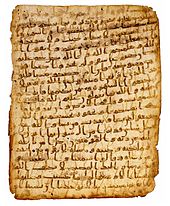

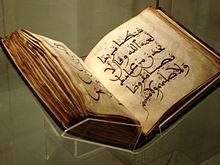
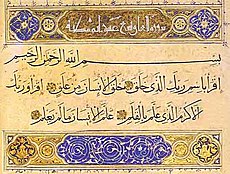

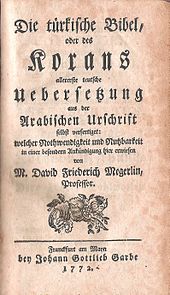
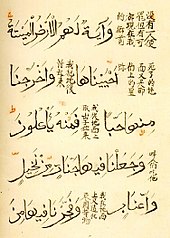
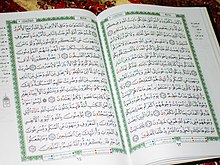

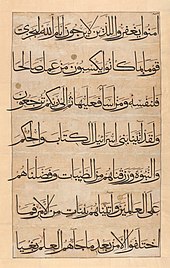




Tidak ada komentar:
Posting Komentar